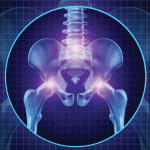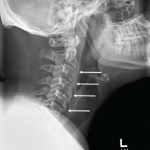Our case illustrates the potential severity of this condition when not addressed in a conventional manner with timely introduction of DMARD therapy and, if necessary, biologic agents.
Conclusion
Down syndrome is a common genetic disease, affecting various systems of the body, including the musculoskeletal system. It mainly causes low bone density, joint instability and the less-documented arthropathy. The presentation of these pathologies might differ between cases, but with early suspicion and specific diagnostic tests, patients can have significantly less debilitating conditions. The purpose of reporting these children is to increase awareness of the association between trisomy 21 and arthropathies, along with other musculoskeletal disorders. Further investigation of this association may give clues to the relationship between genetic and immunologic factors in the pathogenesis of joint inflammation along with other musculoskeletal abnormalities and is highly encouraged.
 Prasanna Bastola, MBBS, is research fellow at Dartmouth Hitchcock Medical Center in the Department of Pediatric Rheumatology. She obtained her MBBS degree from Manipal College of Medical Sciences, Nepal, and is aspiring to become a pediatrician in the U.S.
Prasanna Bastola, MBBS, is research fellow at Dartmouth Hitchcock Medical Center in the Department of Pediatric Rheumatology. She obtained her MBBS degree from Manipal College of Medical Sciences, Nepal, and is aspiring to become a pediatrician in the U.S.
 Daniel A. Albert, MD, is a rheumatologist at Dartmouth Hitchcock Medical Center and a professor of medicine and pediatrics at Geisel School of Medicine at Dartmouth and the Dartmouth Institute. Dr. Albert sees both adults and children with rheumatic disease, and his main areas of focus are RA and vasculitis.
Daniel A. Albert, MD, is a rheumatologist at Dartmouth Hitchcock Medical Center and a professor of medicine and pediatrics at Geisel School of Medicine at Dartmouth and the Dartmouth Institute. Dr. Albert sees both adults and children with rheumatic disease, and his main areas of focus are RA and vasculitis.
References
- Antonarakis SE, Lyle R, Dermitzakis ET, et al. Chromosome 21 and Down syndrome: From genomics to pathophysiology. Nat Rev Genet. 2004 Oct;5(10):725–738.
- Van Allen MI, Fung J, Jurenka SB. Health care concerns and guidelines for adults with Down syndrome. Am J Med Genet. 1999 Jun 25;89(2):100–110.
- McKelvey KD, Fowler TW, Akel NS, et al. Low bone turnover and low bone density in a cohort of adults with Down syndrome. Osteoporos Int. 2013 Apr;24(4):1333–1338.
- Mendez AA, Keret D, MacEwen GD. Treatment of patellofemoral instability in Down’s syndrome. Clin Orthop Relat Res. 1988 Sep;(234):148–158.
- Ali FE, Al-Bustan MA, Al-Busairi WA, et al. Cervical spine abnormalities associated with Down syndrome. Int Orthop. 2006 Aug;30(4):284–289.
- Morad M, Kandel I, Merrick-Kenig E, Merrick J. Persons with Down syndrome in residential care in Israel: Trends for 1998–2006. Int J Adolesc Med Health. 2009 Jan–Mar;21(1):131–134.
- Pueschel SM, Scola FH, Tupper TB, Pezzullo JC. Skeletal anomalies of the upper cervical spine in children with Down syndrome. J Pediatr Orthop. 1990 Sep–Oct;10(5):607–611.
- Dyke DC Van, Gahagan CA. Down syndrome: Cervical spine abnormalities and problems. Clin Pediatr (Phila). 1988 Sep;27(9):415–418.
- Caird MS, Wills BPD, Dormans JP. Down syndrome in children: The role of the orthopaedic surgeon. J Am Acad Orthop Surg. 2006 Oct;14(11):610–619.
- Diamond LS, Lynne D, Sigman B. Orthopedic disorders in patients with Down’s syndrome. Orthop Clin North Am. 1981 Jan;12(1):57–71.
- Zywiel MG, Mont MA, Callaghan JJ, et al. Surgical challenges and clinical outcomes of total hip replacement in patients with Down’s syndrome. Bone Joint J. 2013 Nov;95-B(11 Suppl A):41–45.
- Juj H, Emery H. The arthropathy of Down syndrome: An underdiagnosed and under-recognized condition. J Pediatr. 2009 Feb;154(2):234–238.

